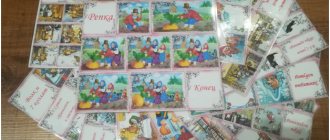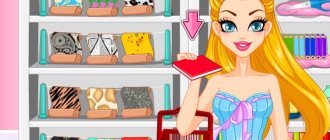Lesson notes on the educational field “Child and Society” in the middle group. Furniture theme
Elena KRAVCHENKO, preschool teacher, State Educational Institution “Nursery-Garden No. 5, Korma”
Tasks:
1Systematize and generalize students’ ideas about different pieces of furniture and their purpose, about the material from which the furniture is made.
2To form ideas about the profession of a carpenter and the tools of his work.
3Develop the ability to compare, find signs of similarities and differences, establish cause-and-effect relationships between objects and materials, generalize and draw conclusions.
4 Cultivate hard work and careful attitude towards furniture.
Materials and equipment: object pictures with images of pieces of furniture, a doll - Kuzya the brownie, silhouettes of furniture, a variety of colored fabric, an easel, counting sticks, basins of water, rags, aprons.
Methods and techniques: visual - examination, demonstration of visual images of furniture; informational and receptive - conversation, explanation, story from the teacher, children, questions, comparison; reproductive – performing certain actions, didactic games, performing labor actions; partially search - when completing a task in the constructive game “Make furniture out of sticks for the brownie Kuzi”; gaming - a surprise moment.
Preliminary work:
Viewing and talking about a multimedia presentation, looking at illustrations, the “Furniture” album, looking at furniture in a group. Conducting the didactic game “Arrange the furniture in the room, bedroom, kitchen.” Painting various furniture, reading poetry and solving riddles.
Form of organization of cognitive activity: group
Class type: combined.
Progress of the lesson
Stage I – introductory (organizational)
Game-sketch “Greeting” (front form of work)
Goal: creating a comfortable, friendly atmosphere, developing a friendly attitude towards peers during gaming activities.
Educator: Guys, I’m in a good mood, and I want to convey my smile to you in a circle (the teacher smiles at the child standing next to him, this child smiles at his neighbor, etc.), let’s smile at each other, show that we are in a good mood.
Educator: Guys, today a guest came to our lesson. This is Kuzya's brownie. He has a new apartment, but there is no furniture yet. Kuzya asks you to help him choose the right furniture.
Educator: Guys, where can I buy furniture? (in the shop). That's right, let's go with you to the “furniture store” and see what kind of furniture there is, and what it is needed for. Are you ready to go to the “store” and help Kuza the brownie? (Yes)
Surprise moment of "Transformation"
Goal: organization of children, motivation for upcoming activities, development of cognitive interest.
Educator: Then we close all our eyes, spin around ourselves and say the words:
One, two, three, We've arrived at the store!
Stage II - main
Educator: So we ended up in a furniture store! Let's see what furniture we have here!
Children look at pictures of furniture, name it, tell what parts it consists of, what it serves.
Educator: We all live in apartments or houses. And in each apartment there are rooms, let's remember what they are called. (Hallway, living room, bedroom, kitchen.)
The corresponding subject pictures depicting the interior of the hallway, living room, bedroom, children's room, and kitchen are displayed on the easel.
Educator: Let's tell Kuza what furniture can be placed in the living room, kitchen, and bedroom. What did you put?
Each of the children puts up one type of furniture and names which room they put it in (kitchen, bedroom, living room).
Educator: All these items can be called in one word - “furniture”. Guys, what is furniture made from (mostly it is made from wood - wooden; doll furniture is often made from plastic - plastic furniture). What kind of furniture is called “upholstered”? (sofa, armchair)
Educator: What do you think the furniture is for? That's right, to make it convenient and comfortable for us.
Educator: Now, to return to kindergarten, you need to close your eyes, spin around and say:
One, two, three, We arrived at the kindergarten.
Educator: Kuzya is very pleased that you helped him, and he wants to play a game with you.
Physical culture minute “Furniture”
Goal: increasing mental activity in class and attention.
One, two, three, one, two, three, (children are walking) The closet is tall - look! (raise your arms high) One, two, three, four, One, two, three, four, (children are walking) We have chairs in the apartment. (squats - springs) There are tables, cribs - (arms stretched out in front of you, palms down, bend forward with arms outstretched) Our furniture is all in order! (make a large circle in front of you with your hands).
Educator: Guys, Kuzy's brownie is having a housewarming soon, let's give him furniture made with our own hands.
Constructive game “ Make furniture out of sticks for Kuzi the brownie”
Goal: development of imagination, observation, constructive skills, mutual assistance.
Children use counting sticks to make different types of furniture.
Educator: Guys, tell me, can furniture break? (Yes) Why is this happening? (When furniture is used for other purposes) And who can fix it? That's right, many dads can do this, and if it doesn't work out, then people turn to a carpenter for help. This is a person who can repair and make furniture, but for this he needs different tools. Which ones do you think?
Pictures are hung on the easel: a plane, a saw, a hammer, a screwdriver.
Educator: Do you think furniture should be looked after? (Yes).
Educator: It turns out that furniture also needs to be looked after: washed, wiped. You can't break it or draw on it. If you treat your furniture carefully and with care, it will last a very long time (it will be like new for a long time).
Problem situation “What should be done to avoid staining upholstered furniture?”
Goal: development of thinking, ability to draw conclusions.
Educator: To prevent upholstered furniture from getting dirty, you can cover it with blankets that can be washed.
Didactic game “New blanket for the sofa”
Goal: activation of mental activity, development of creative imagination and taste.
Silhouettes of multi-colored sofas lie on the tables; children must select the fabric for the bedspread on the sofa by color and choose pillows.
Educator: Well done, guys, everyone coped with the task, now these sofas will look like new for a long time.
Educator: Guys, what kind of furniture do we have in our group? Let's teach Kuzya how to care for furniture. Girls will wipe the tables, and boys will wipe the chairs.
Household work “Wipe the furniture”
Goal: development of labor skills, education of caring attitude towards furniture.
III . End of class. Summing up the lesson
Goal: analysis of the results of students’ activities.
Educator: Guys, let's remember what we talked about today? (About furniture). Where is furniture made? Where do they sell ready-made furniture? What is furniture for? (To sleep, sit, relax, play, etc.)
Educator : That's right, all furniture is important and necessary for people for convenience and comfort in everyday life.
Educator: What is the name of the profession of people who can make and repair furniture? (Carpenter) Do you need to take care of your furniture?
Educator: Brownie Kuzya learned a lot about furniture, he liked playing with you, he thanks you and says “Goodbye.”


